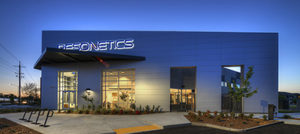
The new facility represents a six-fold increase in size over the former manufacturing plant to support continued growth.
Grayson Beck, SVP velocity and automation, designed the layout with the help of a local architect.
“Everything is designed along the kitchen triangle model—the paths to materials, storage, cutting stations, etc. are optimized,” Beck said.
In addition to optimizing pathways, information and instructions on jobs are delivered through monitors and screens throughout the facility. Each employee has a tablet so “no paper ever gets to the floor,” Beck noted. He said that is a critical detail because having information on paper decreases efficiency. Furthermore, it creates non-searchable data which is inefficient, introduces risk and doesn’t allow for process improvement.
“We can’t use paper-based data to teach machine learning or AI systems, but if it’s in the database, its available for any level of automation in real time,” Beck said.
Beck also explained that with such automated technology, there also has to be an emphasis on people. “Our engineers are 10 feet from the manufacturing floor and have a direct line of sight to the equipment and operators. If there are questions or problems they can help immediately‑its all about speeding communication and workflow.”
The facility boasts no partitions or chairs on the manufacturing floor, which improves communication, efficiency and reduces hierarchy among the staff. Beck, whose background includes manufacturing at Toyota mentioned his commitment to reducing “Muda” or waste in the process.
“Even things like having to open a cabinet to get to a tool is wasted effort,” he said. Instead, all cabinets are replaced with shelves, and are within direct sight. “When something is out of place it is apparent.”
Such concepts are not new to manufacturing, and certainly not new to medtech. However, the focus on learning lessons from the last facility and increasing the emotional engagement of its employees as well as clients was part of Beck’s topmost drivers. Even the kitchen is open with glass walls to provide a view of the manufacturing floor, engineering area and the outdoor break area.
“We want people to come to work in a beautiful setting and not disconnect,” said Beck.

